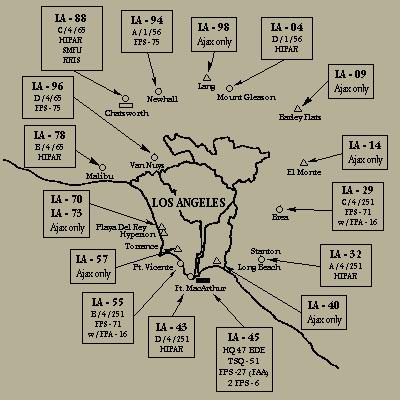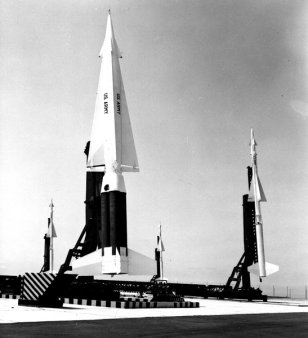"Long before Nike was a sneaker company, the Greek Goddess of
victory lent her name to a missile. The first Nike missile was
conceived at the end of World War II, a conflict in which German
jets left U.S. defense planners at a loss. Conventional
anti-aircraft guns were inadequate against the fast-moving
warplanes. In response, the military turned to another emerging
German technology -- defensive missiles.
The first successful Nike test was in 1951. By 1955, missile
sites could be found near a dozen major American cities and defense
installations. The first-generation missiles, known as Nike Ajax,
were liquid-fueled, with a range of just 20 miles. By the late
1950s, the Army developed a new set of the missiles, known as Nike
Hercules, with greater range -- and the potential to carry nuclear
warheads."
"The Nike-Ajax was the first ground-based supersonic
anti-aircraft missile system to become operational in the United
States. The Nike missiles were deployed at sites in a circular
pattern around key American industrial and military locations. The
first Los Angeles area Nike-Ajax battery was emplaced in the
mountains above Malibu in 1954. By 1958, there were 16 Nike-Ajax
launch sites guarding the greater Los Angeles area, protecting an
area of some 4,000 square miles. The Los Angeles Defense area was
manned by several battalions of US Army Regulars and National
Guardsman, under the command of the 47th Air Defense Brigade from
1954 to 1969."


"The Nike missiles employed the "command guidance" system in
which the major control equipment was ground-based and not part of
the expendable missile. The missiles were guided from a control
area located at least 1000 yards from the launch area. It contained
the radar equipment for acquiring and tracking the target and
missile. Separate radars simultaneously located and tracked both
the target and the Nike missile. Data from these radars was fed to
the electronic computer which sent "commands" to the missile in
flight to guide it to the target. The newer, more powerful
Nike-Hercules missiles replaced the Nike-Ajax during the period
1958-1963. Nike-Hercules had the capability of being armed with a
nuclear warhead. The Hercules was completely powered by solid
fuels, eliminating the troublesome and dangerous liquid fueling
procedure of the Nike-Ajax. Nike-Hercules also brought with it
improved acquisition radar systems and an improved command
coordinating system. The Nike Hercules were installed into modified
Nike-Ajax sites in the Los Angeles area. Only 9 of the original 16
sites were converted to fire the Nike-Hercules missiles.The Nike
Hercules was designed for defense against attack by large
formations of bombers. As the perceived threat changed from bomber
attack to missile attack, the usefulness of the Nike Hercules
diminished. On 4 February 1974, the Army ordered all existing US
Nike batteries were inactivated."
The actual site is open to the public so be sure to go up to the
radar platform to get one of the best views you'll ever have of
Southern California. There is a telescope for the public to view
the surrounding area up there!